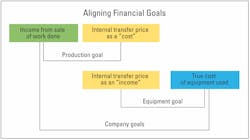Most construction companies have an equipment department or division within the overall organization. This responsibility center builds a specialized equipment team, gives it clearly defined and measurable objectives, and focuses management attention on a critical part of the business.
The work done by other responsibility centers, such as accounting or personnel, is difficult to measure or “monetize.” In these cases, the groups form part of the overhead structure of the business and costs are managed as such. This is not the case with equipment. The output produced—utilized equipment hours—can be measured, and the equipment responsibility center can develop a budgeting system whereby the true cost of owning and operating the fleet is recovered by charging other parts of the company an internal transfer price for the service it provides. This enables the equipment responsibility center to become a cost-recovery, revenue or profit center depending on how complicated management wishes to make matters.
The way the equipment responsibility center structure works within the company is critical for success. Constant bickering, misalignment and gamesmanship between production and equipment achieve nothing. Understanding how the process works, focusing on shared goals, and acting to support the overall organization hold the key to success. Everyone likes to hit their marks, achieve their budgets, and deliver what they promise. But this cannot be achieved at the expense of others in the organization and at the expense of the company as a whole.
Establishing alignment between production and equipment depends more on trust and understanding than on the details of internal operating procedures. Let’s use the diagram above to see how it works.
Production groups and project teams are focused on producing completed construction safely, on time, and on budget. They sell the work they do to clients and earn the company’s income, as shown in the top left hand block of the diagram. In order to do this, they spend money on labor, equipment, materials, sub-contractors and indirect costs. Their goal is to balance money earned with money spent and achieve target margins on their jobs. They see the internal transfer price charged for company equipment as a “cost” based on an internal hourly, weekly or monthly rate and the number of hours, weeks or months the equipment is on their job. As with labor, materials, sub-contractors and indirect costs, they seek to reduce this cost to the minimum. And rightly so.
The equipment responsibility center sees the internal transfer price paid by the various jobs as an “income.” The equipment responsibility center, as shown in the bottom right of the diagram, achieves its financial goals by balancing the transfer price paid by the various jobs with the true cost of owning and operating the equipment fleet. They seek to maximize internal cost recoveries and minimize true costs experienced in order to achieve their budget targets. And rightly so.
The financial goals for the production responsibility center and the equipment responsibility center are clear and measurable but, unfortunately, somewhat in conflict. Production would like to see the internal transfer price paid for company equipment to be as low as possible; the equipment responsibility center would like to see that price as high as possible.
The bottom part of the diagram brings it all together and shows the company’s goal: to optimize the balance between income received from work done and the true cost of the equipment used to complete the work.
As can be seen, the internal transfer price paid by production and received by equipment cancels itself out and, in the final analysis, appears to matter little. Some may say it is all a game and that it does not matter. But it is not. It is deadly serious, and in many cases, this is the game that determines success and failure. Let’s look at three reasons why.
1) Motivation and alignment
The question often comes up, “Should the shop make money?” The answer is easy if you turn the question around: “Should the shop lose money?” Clearly, the answer is “No.” If there is no margin between “making money” and “losing money,” then they will occur with equal probability and you will suffer the agony of a loss just as often as you experience the ecstasy of a gain. Job margins grow a little and shrink a little but jobs seldom, we hope, go into the red. The same should be true for the equipment responsibility center. The internal transfer rate should be set so that the equipment group can hit its marks and enjoy the respectability of profit in exactly the same way as the jobs they support. Nothing is achieved by setting the internal rates at a level where the equipment group frequently fails to make budget and is seen as a drain on the organization.
It is about measuring performance, motivation and alignment. Let’s set rates and design an internal transfer price system that encourages best endeavor, maintains alignment, and ensures that the many risks that lie between success and failure are carried by those who manage them best.
2) Estimating accuracy
Internal equipment rates invariably play an important part in the estimating process. They are, in fact, estimates within the estimate, and there is invariably pressure to reduce rates in order to improve competitiveness at the bid table. We need to say it again and again; you do not reduce equipment costs by reducing the equipment rate. It may be possible to bid competitively and secure work using rates that are below cost. This may achieve production’s goal, but it will most certainly destroy equipment’s goal. Margins made on jobs that use equipment rates that are below reasonable expected costs are a mirage. They disappear when it comes to balancing the equipment account, and the company as a whole achieves little.
Focusing on company goals and knowing that these are the sum of gains and losses in production and equipment is the key to success and estimating accuracy. Nothing is achieved by using rates that do not reflect reasonable expected cost in order to improve competitiveness at the bid table or pad the equipment account. Estimating accuracy demands that you know your costs and use that knowledge to produce reliable estimates.
3) Budget reallocation
Budgets are plans. They tell us where we wish to go and where we are likely to land. We know there will be gains or losses on budget, and we know that these variances will need to be reallocated or consolidated into the company’s results or into the results produced by downstream responsibility centers. Everyone enjoys a budget gain, and production managers are rightfully pleased when a positive variance on the equipment account is reallocated and consolidated into their operating results. They see it as a just reward for the efforts they have made to train operators and use the organization’s equipment correctly.
The opposite is true when variances are negative. Production managers will see no reason why they should absorb budget losses due to inefficiency and bad decision making in the equipment group. Relationships are tested and everyone feels cheated one way or the other.
The way in which budget variances are reallocated to downstream responsibility centers is extraordinarily complex. Accurate costing and cost allocation is required to ensure that the process is seen as fair and reasonable. Without this, the process is invariably seen as arbitrary and many negative behaviors result. The answer, as with estimating accuracy, is to know your costs, plan carefully, and produce the best budgets possible.
The responsibility center concept whereby organizations are divided into clearly defined teams with measurable responsibility for a given aspect of the business is a powerful tool. Like most powerful tools, it must be used with care and with a full knowledge of both the upside and the down side. This is particularly true when it comes to equipment management where equipment and production are mutually interdependent and where success or failure is so dependent on interpersonal relationships within the organization.





